You have just scoured the internet for the latest “fool-proof” cold email template.
Now, after a bit of copying and pasting…
…You send out a few hundred cold emails excitedly and wait for the money to roll in.
A day goes by…
A week goes by…
And NOTHING.
To your disappointment, that magic template didn’t work.
So, as you say goodbye to the 100 prospects you flushed down the toilet, you wonder what it takes to run a successful cold email campaign.
Templates are obviously not the answer, so what is?
Instead of spending hours searching for templates that don’t work, read this article as a cold email expert shares how to run a successful campaign.
Below we will discuss in detail 2 cold email campaigns (with the STRATEGY and TEMPLATES) that we used and exactly how we did it.
NOTE: The 2 campaigns you’re about to see got an X and Y percent reply rate. Pay close attention to the strategy, list, and “value proposition” used in the templates — as these lessons can actually boost your response rates.
*Unlike a random template on the internet.
Cold email campaign number 1
Some background – Like all good cold email campaigns, the campaign begins with an end goal.
What we wanted to achieve with this campaign was to reach out to founders of fast-growing companies that were using cold email, and get them to reply with tips and advice that they use during their own cold email campaigns.
Step 1: Build a list of prospects.
The first thing that we did in this campaign was fire up Sales Navigator and search for companies.
What type of companies were we looking for?
We are looking for founders of fast-growing companies that use cold email outreach.
Note: It’s not always easy to filter companies on each and every criteria you need.
For example, finding companies that are using cold email outreach isn’t necessarily posted online or on Linkedin.
Therefore, we needed to dig a little deeper in other places to figure out which companies are using outbound.
You might even need to use different prospecting tools, to help you refine your list.
These were the filters we used to find the companies that we were looking for:
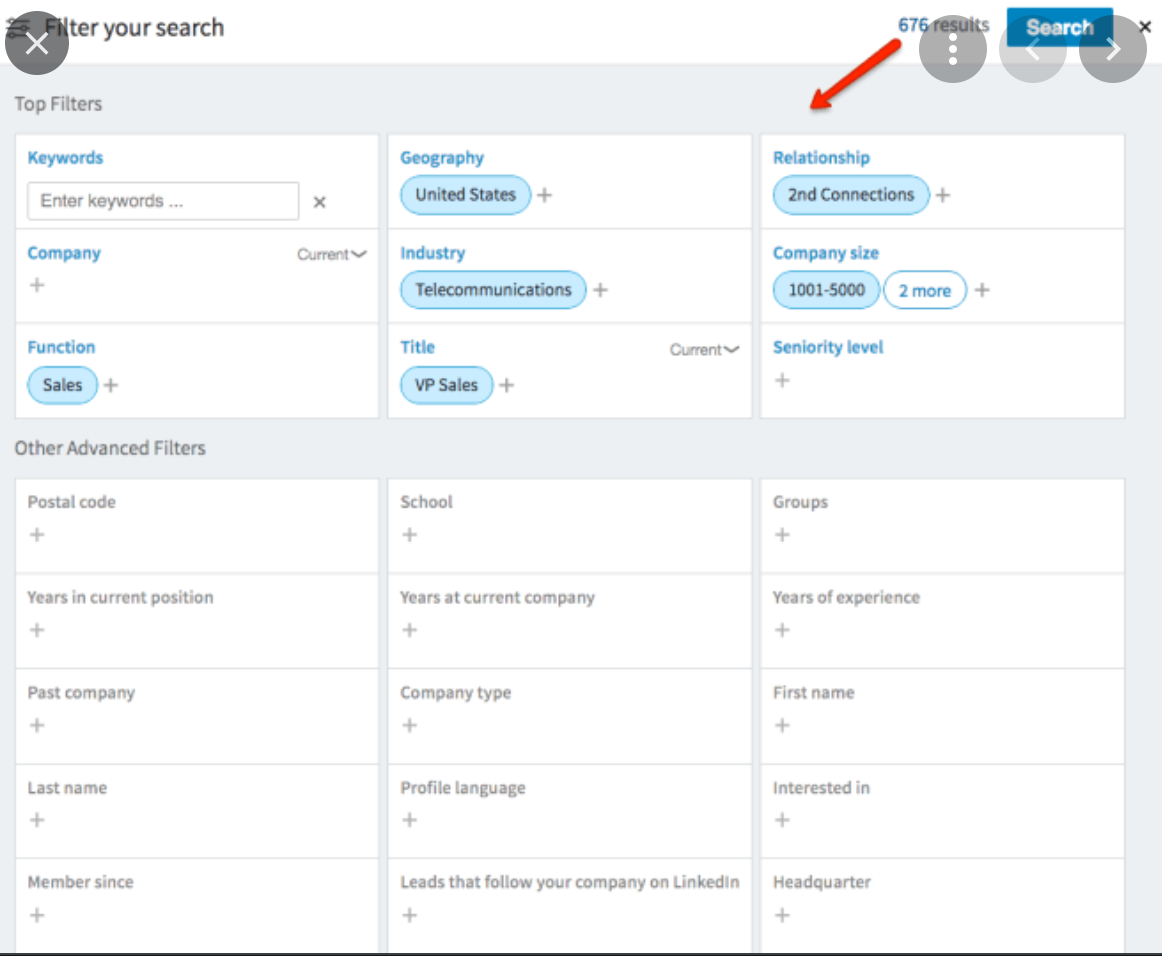
- We filtered by location, which was the United States.
- We also filtered by the number of followers. The more followers the company had, the more well known they would be.
- When it came to the number of employees, we capped it at a specific amount.
The reason for this is that we wanted to find the smaller and faster companies that were doing remarkable things with their sales departments.
For example, we looked only for those who had 5 or fewer employees, indicating that they must have been using an outbound process to have grown so quickly.
(We did not want to target enterprise companies that have been around for many years.)
We picked up 2 main industries:
- Computer software
- Internet software
This gave us 200 companies to look at, and once we had these accounts pulled up on Sales Navigator, it was time to transition to find the people we were interested in talking to at those companies.
Which filters did we use?
Well, we wanted to find founders, co-founders, and CEOs, ONLY.
Why?
We wanted to speak to those who had built their company to a significant level quickly, with small teams (Remember your end goal). So then, we then typed in “owner” or “CXO.” in the seniority level filter.
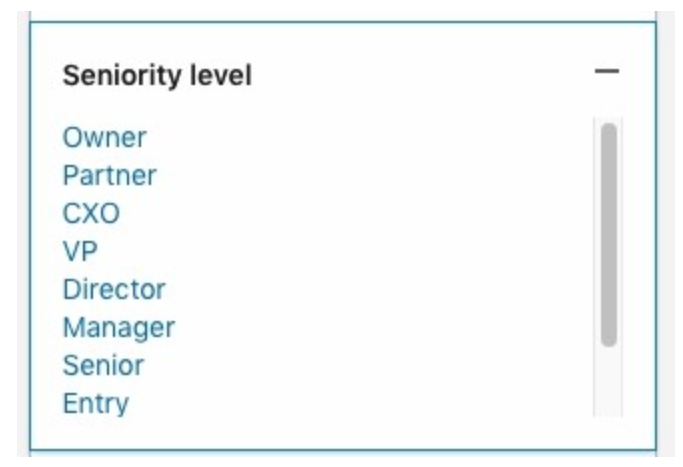
Step 2: Find the email address of the owners, or CXO’s
In order to find the email addresses, we needed to use different tools. Some data mining tools and verification tools that we used were:
Once we got all the email addresses, we had about 140 leads that matched all our criteria.
We then ran those email addresses through “NeverBounce” and only ended up with 71 verified email addresses.
(We threw out all the other prospects that would have been risky or unverified.)
Why go through so much effort?
This does take a lot of work, but if you have a targeted list, the chances of getting replies to your emails are so much higher.
Step 3: Research each prospect for personalization
Salesbread is a significant fan of personalizing emails and Linkedin messages. There are a few reasons for:
- It shows the prospect that you have done your homework, and you’re not just a spammer.
- It creates better deliverability
- Personalization makes your cold email stand out
Personalization means finding something about the prospect that you can use in your email.
For example, were they featured on a podcast?
Do they have an interest in certain groups on Linkedin? Or an interest in hiking, or charity?
You could also mention something noteworthy about the company if you are targeting specific companies.
Remember
Personalization does not just have to be per individual, but it could also work for a group. Especially if your list is super targeted.
How long did the research take?
This took about 2 hours to go through each website for 71 prospects manually. So, yes, it does take time, but it pays off in the end.
Pro Tip:
Clean your lists before writing any merge tags.
The reason?
You don’t want to waste hours researching personalization for prospects who are not a good fit for your campaign.
Truth is, personalization means you write a tailor-made message so that your recipient KNOWS you wrote it for them and for nobody else.
Step 4: Write your email copy
Have a look at the copy below for the email that we sent out to the owners of these companies.
Notice:
- We used a “curiosity grabbing: subject line, with the company’s name and a question.
- Our intro sentences were customized to the person. (One of the biggest mistakes that cold emailers make is not adding in personalization. This is imperative for good outreach)
For example, one intro sentence said:
“Inspiring to hear that your company began, by helping your father startup Brooklyn Butcher shop.”
Robots can not fake these customizations. Therefore, people know that you are speaking to them personally, as a human on the other side of their screen.
- The email was concise and to the point. Notice that we only used two sentences, excluding the intro and the PS.
- Don’t brag in the email, but rather praise the prospect about themselves and their accomplishments.

Step 5: Send an immediate follow-up email
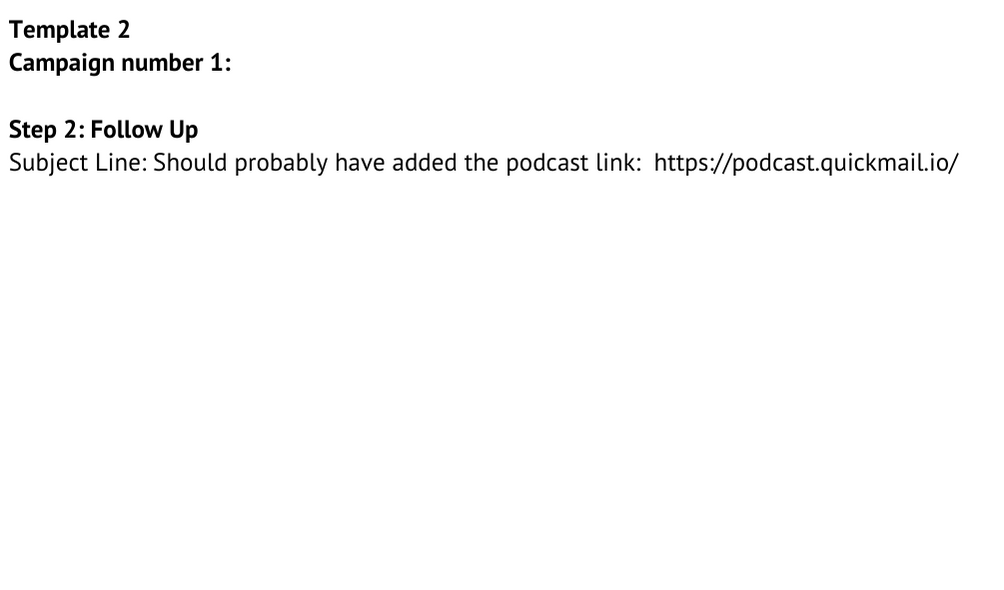
We kept the subject line the same as the follow-up cold email, but we basically added one sentence on the first line for the copy.
That’s it.
Notice how this sentence makes it seem as if we “forgot” something in our previous email. This is a subtle way to get another email in.
All we did for this mail was add in the podcast link.
This adds a human touch that no bot can achieve and the link also verifies that there is a podcast.
Try to follow up without delay and just add in some extra info; this will make you look like a genuine person.
We actually received a reply from a prospect that said they found us more approachable because we sent an immediate follow-up.
So this tactic does work.
Step 6: Send an official follow-up cold email.

Next, you need to wait 3 days before sending the official follow-up email.
With this, we kept the cold email subject line the same.
Which was “ Featuring (Company Name) Podcast?
Have a look above at the copy we used for the body of the email.
(Again, this is not a traditional bump email, but rather one that has been written in such a way so that it gets a reply.)
Notice the quick one-liner again mentioning that we know they are busy, and then we jump into 2 quick questions that will grab the prospect’s attention.
The questions are also a way to filter out the prospects once again.
See how we asked, “Has cold email ever played a role in your company’s growth?”
If it hasn’t, then it tells us that we can move on to a different prospect. But if the company has used cold email, these questions tend to stick out as talking points because they are cold email experts.
The questions also stick out because it is something directly aimed at the prospect. Something special just for them. (This often gets a higher response rate than impersonal the usual boring cold email)
Another essential point to remember is that the question is super-specific.
We didn’t just ask, “Do you send cold emails?” We asked: “Has cold email ever played a role in your company’s growth.”
In your cold email copy, try to be as specific as possible.
This helps to find the correct person. If they haven’t used cold email, we just move on to prospects who have.
Step 7: Do extra research, AKA “The Research Task.”
If you still haven’t received a reply after about a week, do some additional research. This allows us not to blindly follow up but rather add more personalization in the next email.
Hopefully, this is the “silver bullet” we need to get a response.

Step 8: Send the last email
This email is basically the “break up” email. Take note of the scarcity of the email.
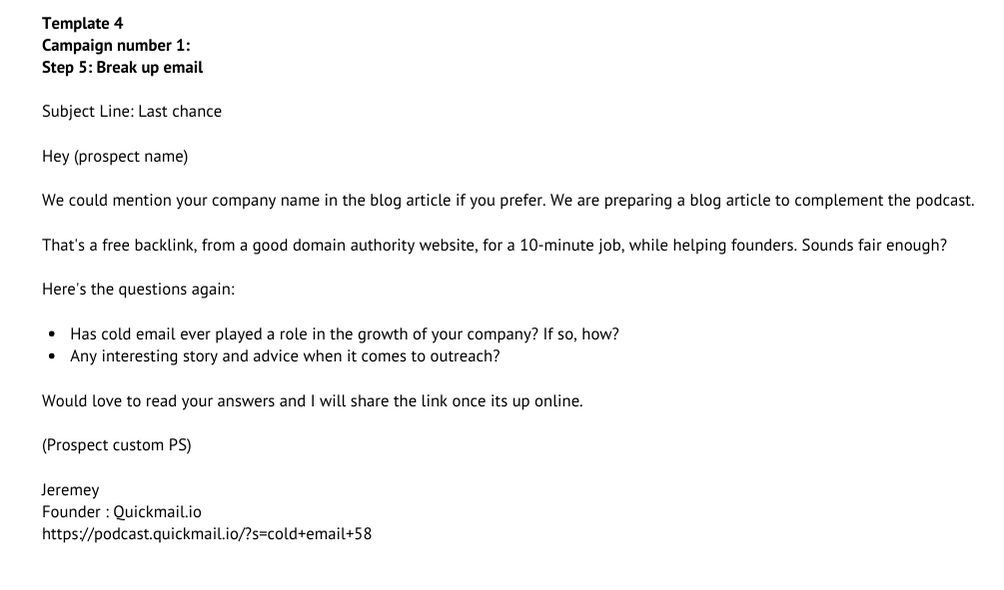
Our subject line reads “Last Chance.”
The first line states how we could mention their company name in a blog post if they prefer.
We also added the “custom PS” at the end, which could even include a clear CTA once again, or the extra research you did on the prospect.
Take note of the benefit of replying to us.
The prospect can get featured on a blog post, which is a free backlink from a good domain authority website.
If they still don’t reply, then it means that they are not interested at this specific time.
Let’s Recap:
- Build your list
- Find the email addresses
- Write your email copy
- Send an immediate follow-up email
- Send the official follow-up email 3 days later
- Do some extra research on the prospect for your following email
- Send the break-up email if you do not get any replies.
Have a look at the step by step images below for a quick reference:




Stats for Campaign 1
Verified Prospects
%
Open Rate
%
Reply Rate
We had no negative replies, and this makes sense because of the “value proposition.”
Pro tip: Check out Good Sales Emails. This is a great company website that offers cold email templates that you can check out for some ideas, but it also lists the email addresses of hundreds of businesses that you can download. In addition, this site shares cold email campaigns from some of the best companies out there.
This is where we started prospecting for campaign number 2.
Cold Email Campaign Number 2
Some background:
What we didn’t like about the first campaign was that we couldn’t find out exactly which companies used cold email outreach.
We would have liked this info before we sent the emails out. Therefore our list was not as targeted as we would have liked it to have been.
But check out campaign number 2.
This was much more targeted, as we used Good Sales Emails.com for a list of companies that we were 100% sure of used cold email outreach.
Therefore this was a red-hot list for being ultra-targeted, as we knew everyone on this list was sending out cold emails.
So when we offered them the chance to be on a podcast, the chances of them responding would be high.
The challenges
The only problem with these emails is that we weren’t sure who wrote them, whether it was the CEO or a salesperson.
But we assumed that the right person was the CEO because the CEO would know the activity that was being performed for their company’s outreach.
We also weren’t sure if these companies used cold email to grow their businesses.
Our plan
When it came to the cold email copy, we were leaning on the fact that we found their emails on the website Good Sales Emails.
We used this to add personalization into the copy.
We didn’t go into major personalization for each prospect in this campaign, like the previous one, but rather compliment them on their approach.
We followed the exact same steps as we did with the first campaign, except we did not do deep research about each prospect, as we already had a list.
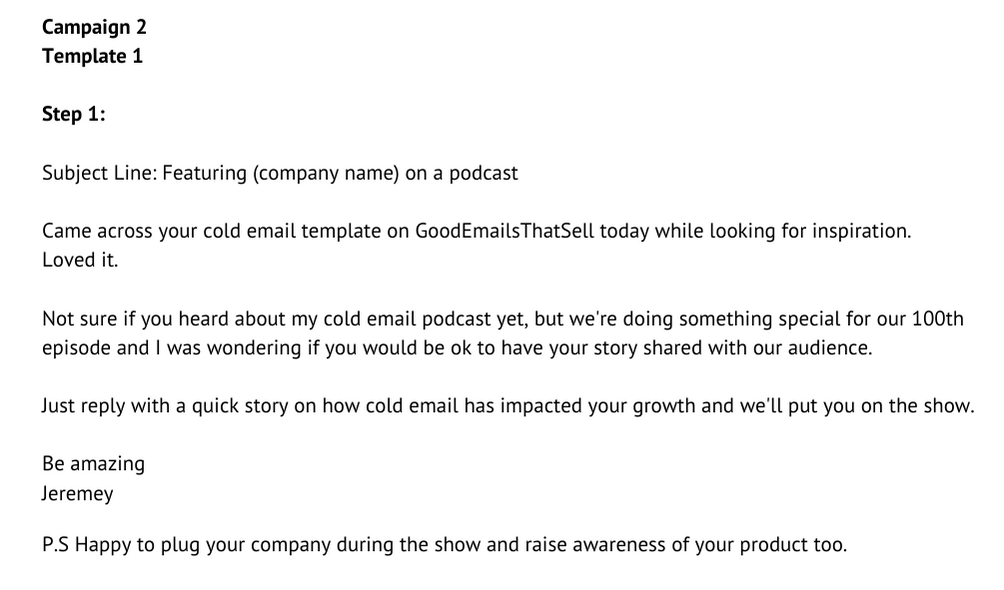
As you can see, we used the same subject line that we did with the first campaign.
NOTE: We also added in a hyperlink to GoodSalesEmails, so that if they clicked on the link, it would go directly to their campaign.
Notice that there was no in-depth research about the prospect or their company. We just mentioned how we found them.
Instead, we were leaning on their curiosity and adding value to them by wanting them on the podcast.
This would hopefully make them curious enough to reply.
Remember, if the list is good enough and the offer is irresistible, you will get replies.
Next Step: Send a quick follow-up.
As we mentioned, we used the exact same strategy. We just sent the link to our podcast as if it were an afterthought.
Check out our quick follow up cold email:
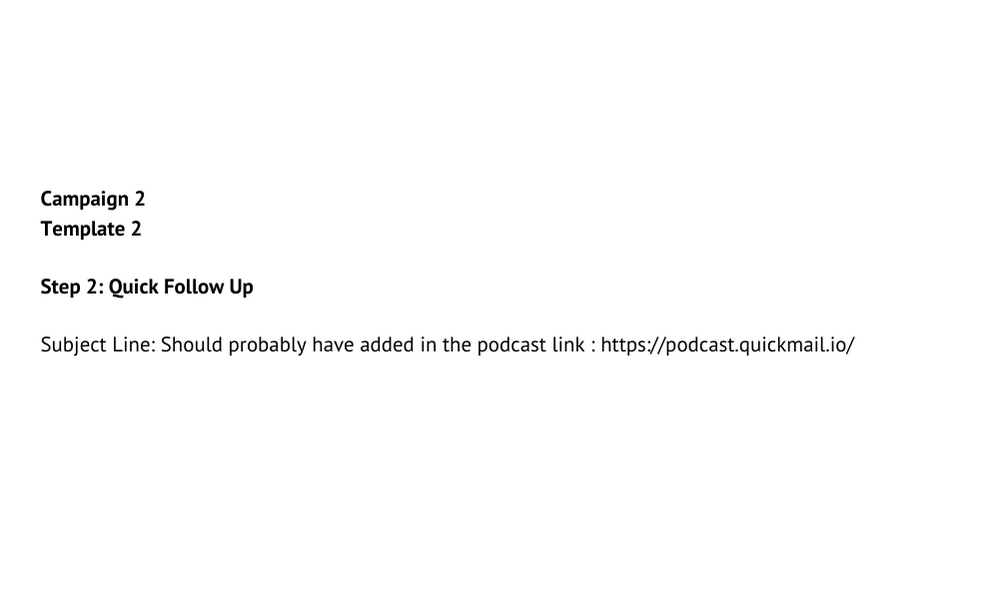
Wait 3 days and send the official follow-up cold email:
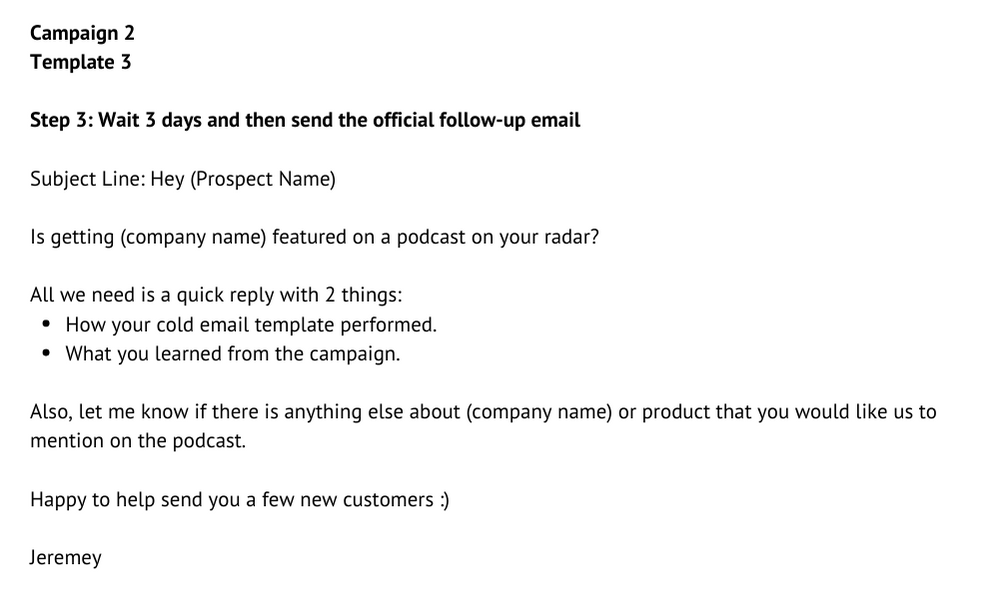
This email has a different approach.
It takes a few steps back and tests the waters to see if this particular prospect could care less if they are featured on a podcast or not.
Notice again how we reinforce the value to them; by saying that we are happy to send new customers their way.
We did not have a clear CTA at the end, but we were hoping that the value added to the prospect would make them want to reply.
This approach also allowed us to test a different tone to see which campaign would be the winning one.
Send the “Break up” email.
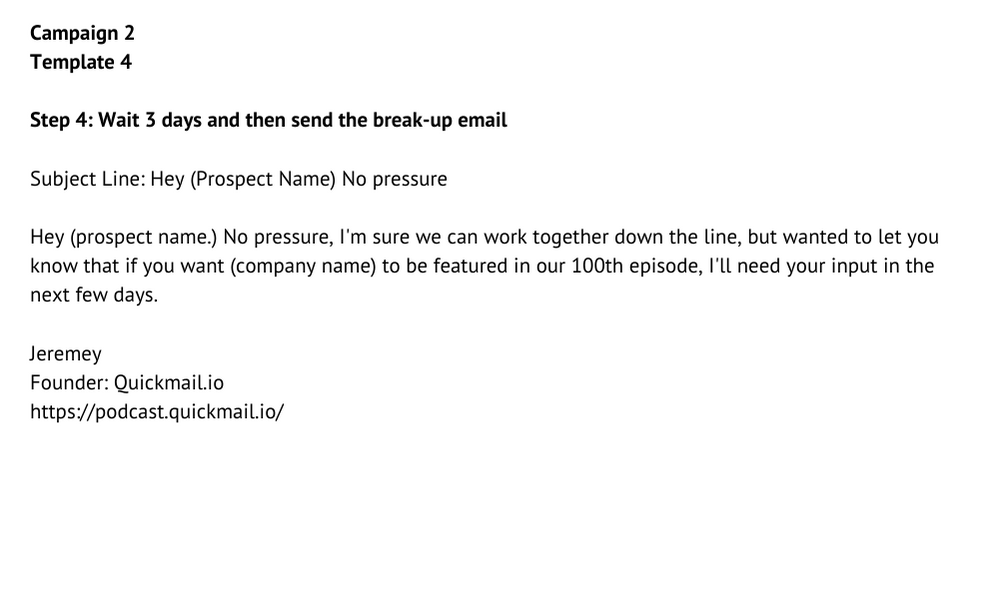
Once again, we waited another 3 days ( we find that this is the best time to wait.) before sending the last email.
Again, we used the same subject line and the prospect’s personal names.
The message here was pretty straightforward.
What do you think? Which campaign did better? The one with the ultra-personalized messages? Or the one where the list was ultra-targeted?
Cold Email Campaign number 2: Stats
Verified Prospects
%
Open Rate
%
Reply Rate
Why did campaign number 2 do less impressively?
As mentioned above our Call to Action was not very clear.
Always have a strong CTA.
Our follow-up emails might also have been a little too tight, forcing people to respond or not get featured.
It also lacked personalization. This proves that personalization is vital, as it cost us 4x the response rate.
Relevant content is also significant because people will not be interested in something that is not relevant to them.
(This might have been one of the biggest problems with the second campaign because we were unsure who we were reaching out to exactly.)
BUT interestingly, we got a response from our second campaign from someone who was super keen to be featured on the podcast, and their interview was mind-blowing.
That’s the thing, you might have a lower response rate in one campaign, but those who responded might be the right person for your product/service.
The best way to measure good success is to look at the metrics holistically and see which campaign actually got you that one qualified lead.
Quick Recap for the second campaign
- We used GoodSalesEmails.com to find a list of companies that used cold emails, hoping that they would be the right contact.
- Write your email copy.
- Send an immediate follow-up email
- Send the official follow-up email 3 days later
- Send the break-up email if you do not get any replies.




In Conclusion
Hopefully, these 2 case studies give you some in-depth insight into what makes a successful cold email campaign.
This campaign combined had a 58% reply rate.
We have been cold email experts for over 12 years now and have tested hundreds of different strategies to see what works and what doesn’t.
This is the exact breakdown that we use for our cold email campaigns, and the stats prove that it works.
Would you like to see what we can do for your B2B sales? Get in touch, it might just be the right time to take your small business to the next level with higher response rates.